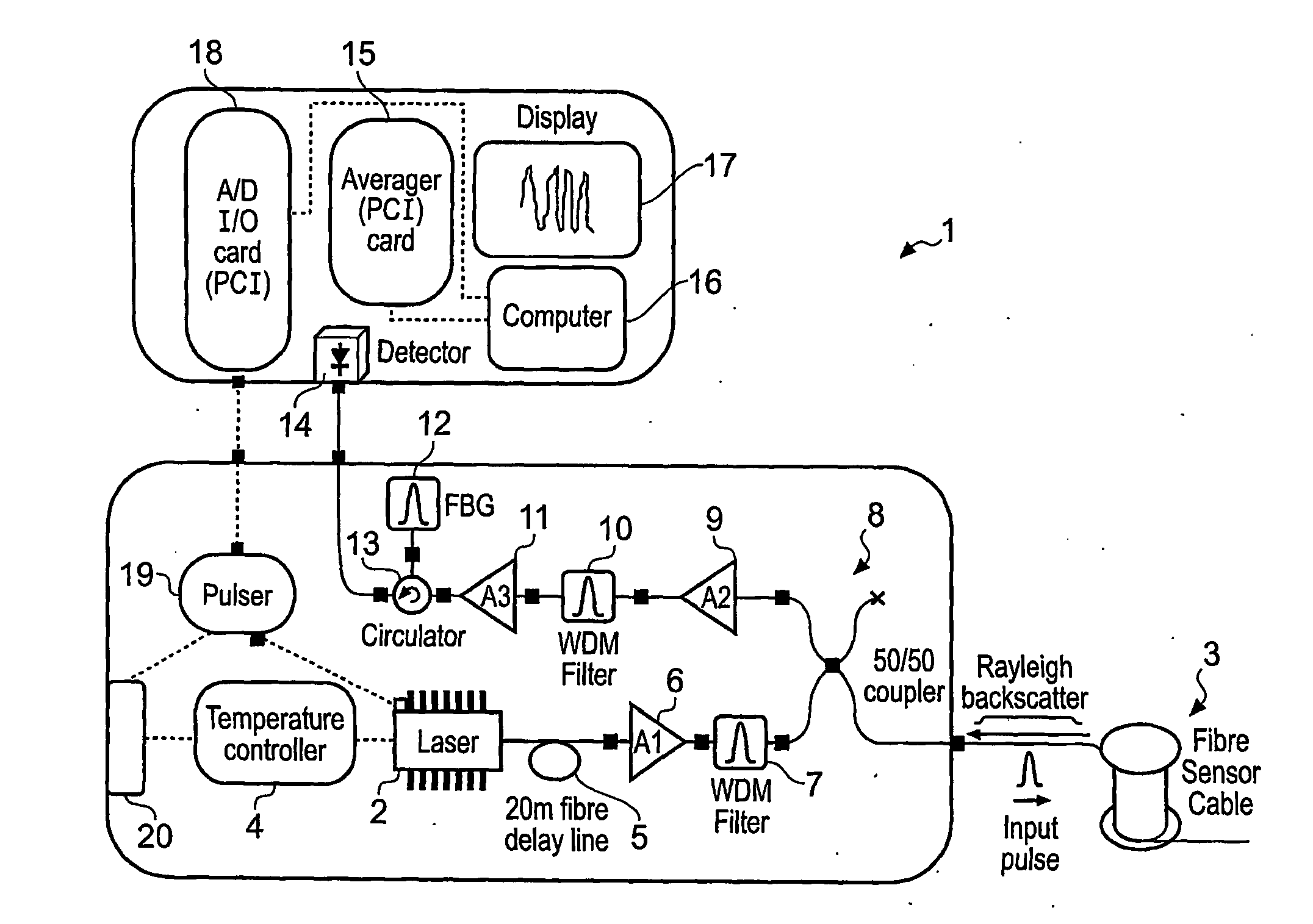Detecting a disturbance in the phase of light propagating in an optical waveguide
- Summary
- Abstract
- Description
- Claims
- Application Information
AI Technical Summary
Benefits of technology
Problems solved by technology
Method used
Image
Examples
first embodiment
[0047]Referring to FIG. 1, a partially coherent Optical Time Domain Reflectometry (OTDR) apparatus 1 according to the present invention has a light source comprising a directly modulated semiconductor Distributed FeedBack (DFB) laser diode 2 for transmitting light pulses along a monomode optical fibre 3. DFB laser diodes are common in optical wavelength division multiplexed (WDM) telecommunication networks and, in this embodiment, the DFB laser diode 2 is of the type typically used in 2.5 Gbps WDM telecommunications. A temperature stabilising unit comprising a Peltier element 4 is provided to control the temperature of the DFB laser diode 2. As the temperature of the DFB laser diode 2 changes, so does the wavelength of the light pulses it transmits. The Peltier element 4 enables precise wavelength control over around a 1 to 2 nm range, so that the wavelength of the light pulses can be adjusted. Typically, the wavelength of the light pulses is around that for which the monomode optic...
second embodiment
[0067]In one version of the second embodiment, the photodetector 14 is an InGaAs p-i-n photodetector with a three stage transimpedance amplifier, such as model 2053 from New Focus, having an electronic bandwidth of 700 kHz, a voltage responsivity 1.89×106 V / W and an NEP of 0.34 pW / rtHz. For light pulses of duration 500 ns (50 m) launched into the optical fibre 3 with power 500 mW, the predicted SNR is about 35 dB. The logarithm of the reciprocal of visibility parameter VI is equivalent to a signal level around 18 dB, which means that the SNR is around 17 dB higher and the temporal speckle pattern should be easily distinguishable from the predicted noise.
[0068]In another version of the second embodiment, the photodetector 14 is an InGaAs avalanche photodiode with an integrated hybrid preamplifier, such as model C30662E from Perkin Elmer, having an electronic bandwidth of 50 MHz, a voltage responsivity 3.4×106 V / W and an NEP of 0.13 pW / rtHz. IF the electronic bandwidth is limited to 7...
PUM
 Login to View More
Login to View More Abstract
Description
Claims
Application Information
 Login to View More
Login to View More - R&D
- Intellectual Property
- Life Sciences
- Materials
- Tech Scout
- Unparalleled Data Quality
- Higher Quality Content
- 60% Fewer Hallucinations
Browse by: Latest US Patents, China's latest patents, Technical Efficacy Thesaurus, Application Domain, Technology Topic, Popular Technical Reports.
© 2025 PatSnap. All rights reserved.Legal|Privacy policy|Modern Slavery Act Transparency Statement|Sitemap|About US| Contact US: help@patsnap.com



